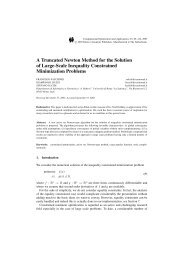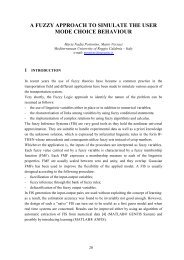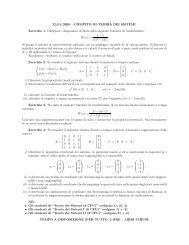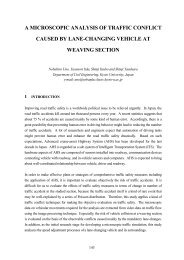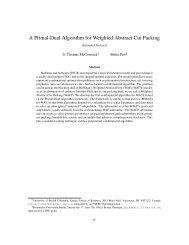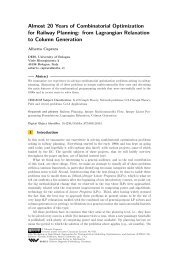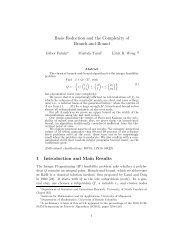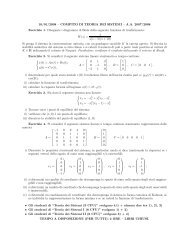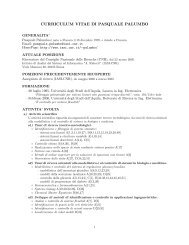short-term travel time prediction using a neural network
short-term travel time prediction using a neural network
short-term travel time prediction using a neural network
You also want an ePaper? Increase the reach of your titles
YUMPU automatically turns print PDFs into web optimized ePapers that Google loves.
3.4 Prediction <strong>using</strong> artificial <strong>neural</strong> <strong>network</strong>s<br />
ANNs are based upon biological <strong>neural</strong> <strong>network</strong>s by mimicking their architectural structure<br />
and information processing in a simplified manner. They both consist of processing<br />
elements called neurons that are highly interconnected making the <strong>network</strong>s parallel<br />
information processing systems. They are capable of tasks such as pattern recognition,<br />
perception and motor control that are considered poorly performed by conventional linear<br />
processing. These parallel systems are also known to be robust and to have the capability to<br />
capture highly non-linear mappings between input and output. ANN applications in<br />
transport can be found in e.g. Dougherty (1995) and Huisken (1998 and 2001).<br />
Here Multi Layer Feedforward (MLF) <strong>neural</strong> <strong>network</strong>s were used. The MLF is a supervised<br />
learning <strong>network</strong> meaning that during the training phase all inputs are mapped on desired<br />
outputs. The error, i.e. the difference between the actual and the desired output, is a criterion<br />
that is used to adjust the weights of the neurons iteratively so that the total error of all inputoutput<br />
pairs is minimised. The algorithm responsible for this method is called the learning<br />
rule. More comprehensive information on MLF <strong>neural</strong> <strong>network</strong>s can be found in any<br />
textbook on ANNs.<br />
MLF <strong>network</strong>s will be trained with the most accurate <strong>travel</strong> <strong>time</strong>s as targets. The number of<br />
input variables is: 21 (induction loops) * 2 (quantities: speed and intensity) + 1 (<strong>time</strong> of day)<br />
= 43. This high number of inputs resulted in <strong>time</strong> consuming training phases so preprocessing<br />
was used to cut the input down to 12 inputs. The data set was divided into 3<br />
equally sized subsets (for cross-validation purposes) where one subset was used as test set to<br />
find the optimum number of hidden neurons and epochs (training cycles) and to prevent the<br />
MLF <strong>network</strong> from overfitting.<br />
4 RESULTS & CONCLUSIONS<br />
The <strong>prediction</strong>s of the three methods were compared with the <strong>travel</strong> <strong>time</strong>s de<strong>term</strong>ined by<br />
RT4. Travel <strong>time</strong> <strong>prediction</strong> becomes interesting when free flow conditions no longer hold.<br />
Therefore <strong>prediction</strong> was only executed when <strong>travel</strong> <strong>time</strong>s exceeded 500 seconds (i.e.<br />
average speed under 82 km/h). To compare the method’s performances several measures of<br />
error were de<strong>term</strong>ined (see formula 2): the Mean Relative Error (MRE) [%], the Mean<br />
Absolute Relative Error (MARE) [%], the Mean Time Error (MTE) [seconds], the Mean<br />
Absolute Time Error (MATE) [seconds], and R-squared.<br />
MRE =<br />
t ˆ n<br />
− t<br />
∑<br />
n<br />
MARE =<br />
n n ⋅ ˆ t n<br />
t ˆ n<br />
− t<br />
∑<br />
n<br />
MTE =<br />
n n ⋅ ˆ t n<br />
∑ ˆ t n<br />
− t n<br />
n<br />
MATE = ∑ t ˆ n<br />
− t n<br />
n<br />
(2)<br />
where n is the number of cases, t ˆ n<br />
is the <strong>travel</strong> <strong>time</strong> to be predicted (target value from RT4),<br />
and t n<br />
is the <strong>travel</strong> <strong>time</strong> generated by the model.<br />
n<br />
n



